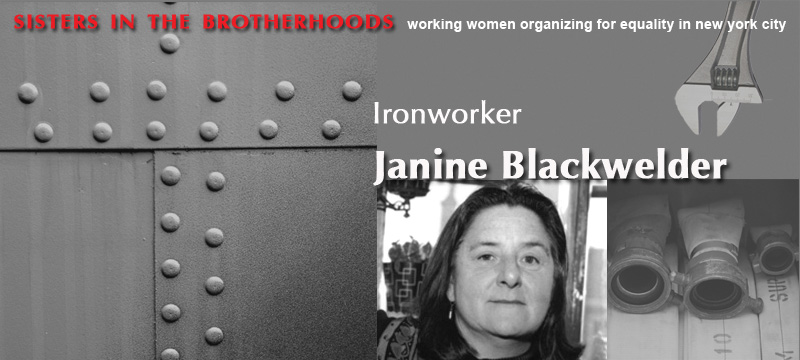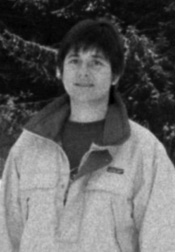 |
|||||||
|
|||||||
|
Janine Blackwelder consciously chose a nontraditional job “for the cause” of women’s equality.” She also liked the idea of working with her hands to produce a tangible result and getting paid well for it.
She found out that the International Association of Bridge, Structural, Ornamenta and Reinforcingl Ironworkers was accepting applications for apprentice ironworkers. She took a series of state-supervised tests, and then the union called her into its apprenticeship class in 1979. The only woman in her class and the first to join Local 580, she trained as an ornamental ironworker. She began her apprenticeship the same year that Local 580 and the federal government reached an agreement that that opened up the program to minority males. Her mother had worked periodically as a telephone operator, and her father, a salesman with a construction-related project, did all the fix-it repairs at home. As child Blackwelder absorbed considerable knowledge while helping her father do repairs at home. Later she realized that some of that information came in handy while she was acquiring the skills of her chosen trade. At school and on the job, she was in the position of every other apprentice who was struggling to gain skills. The partnership between journeyman and apprentice is the critical component. Both women and men in the skilled trades encountered situations in which some journeymen would resist sharing their knowledge. Others were willing and excellent tutors. Blackwelder’s first foreman was, in her words, “a good guy.” She graduated at the top of her class and began looking for work as a journeyperson. She quickly learned that the union considered the journeyman a “kind of free agent or an independent contractor, or a freelancer in some respects.” She also discovered that two systems governed the search for jobs: the industry’s formal rules and the informal connections that work to the disadvantage of people considered “outsiders”—particularly women and minority men. Members of Local 580 had the right to solicit their own work through a network consisting of the union, employers, foremen, relatives, and friends. Kinship and cronyism are powerful factors that influence hiring, much to the disadvantage of non-favored members. Blackwelder worked at the trade for 12 years. To survive, she adopted a self-deprecating style that downplayed the obvious differences between herself and her co-workers.She kept learning her trade and coming back. Along with some of her fellow union members she tried to challenge the unfair practices of the hiring hall. This short-lived group of rank-and-file members, Alters, had an impact on the local’s 1990 election but functioned mainly as a “means to same employed” for some individuals. The group soon fizzled out. Meanwhile, information about Local 580’s ties to a major New York City crime family surfaced in 1991. Two Local 580 officials were killed, including the man who was Blackwelder’s B.A. (business agent for 580). In November 1991 she decided to leave the city because she no longer felt safe on the job. She moved to New England, where she worked for a nonprofit organization, and then to Texas. She became a travel agent and taught English as a second language to Mexican immigrants. In her oral history Blackwelder describes the nature of the ironworker trade and its physical demands and her the experience of being a woman on the job. Years later she made a poignant admission: “What I really didn’t consider coming into building construction is what it would feel like to be surrounded completely by men and almost never find another woman on the job site I was on. I didn’t think about it. Actually that’s something that did affect me. Just to be surrounded by men. You know, I don’t know what to say about it. There’s too much to say about it.” |
||||||
| |||||||
Copyright 2012 Jane LaTour/Talking History Photo of Blackwelder by Gary Schoichet |
|||||||
